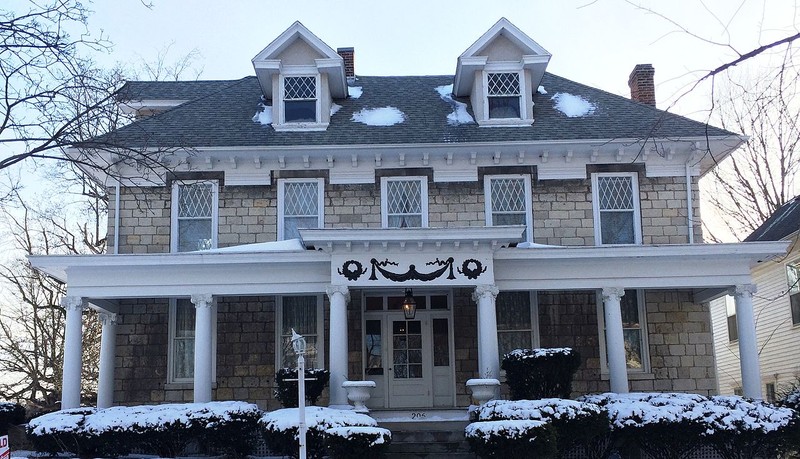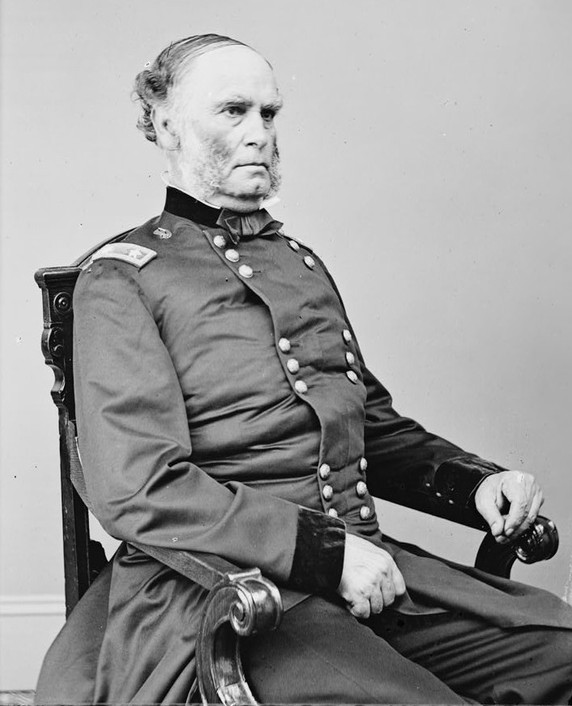Gen. Samuel R. Curtis House
Introduction
Text-to-speech Audio
Congressman, engineer, U.S. Army major general, and Keokuk mayor Gen. Samuel R. Curtis (1805-1866) built this historic home in 1849. Curtis was one of the leading figures from Iowa during the 19th century. He is best known for his victories during the Civil War at the Battle of Pea Ridge in 1862 and the Battle of Westport in 1864. As for the house, in addition to its association with Curtis, it is a fine example of Greek Revival architecture with elements of the Adamesque style included in the design. It features a large porch with Ionic columns, diamond-paned windows on the second floor, and decorative garland. The house is privately owned but is open to the public as an Airbnb rental. According to the Airbnb listing, President Abraham Lincoln dined and stayed overnight at the house.
Images
A fine example of Greek Revival architecture, Gen. Samuel R. Curtis built this house 1849. Curtis is best known for his victories over the Confederates at the Battles of Pea Ridge and Westport during the Civil War.

General Samuel R. Curtis (1805-1866) was an engineer, lawyer, politician, and U.S. Army major general.

Backstory and Context
Text-to-speech Audio
Samuel R. Curtis was born on February 3, 1805 in Champlain, New York and four years later moved to Ohio with his family. As a young man, he attended the West Point military academy where he studied engineering. After graduating in 1831, he was assigned to the 7th infantry and stationed at Fort Gibson in present-day Oklahoma. In November that year he married his wife, Belinda. In 1832, Curtis resigned his commission and moved to Ohio where he studied law and worked as an engineer on the National Road, which was the first major highway built by the federal government, and on the Muskingum River hand-operated lock system. He was admitted into the bar in 1841 and practiced in Wooster, Ohio, and also became involved in the Whig Party. During the Mexican-American War began, he commanded the 3rd Ohio volunteer regiment and served as military governor of occupied Mexican cities.
After the war, Curtis became the city engineer of St. Louis where he oversaw the construction of the sewer system that was used for 150 years. He then moved with his family to Keokuk in 1853 and continued practicing law. He also became more involved in local politics and was elected mayor in 1856. In the fall of that year he was elected as a Republican to his first of three terms in Congress. During his time in office, he supported the idea of a trans-continental railroad and was ardent opponent of slavery and its expansion into western territories. He also served on several military committees.
After the outbreak of the Civil War, Curtis became colonel of the 2nd Iowa volunteers in April 1861 and was ordered to occupy Hannibal, Missouri. On August 4th, he officially resigned from Congress and was promoted to brigadier general backdated to May 17. In December he was given command of the District of Southwest Missouri and the Army of Southwest.
Over the course of the coming months, he drove Confederate forces into Arkansas and established a base along Little Sugar Creek (near the city of Bentonville). Determined to push Curtis out of Arkansas, Confederate General Earl Van Dorn, who commanded the Army of the West, met Curtis at Pea Ridge, which is just north of Little Sugar Creek, on March 7, 1862. However, Curtis had moved 10,500 of his men to Pea Ridge after learning of Van Dorn's approach. When Curtis' scouts informed him that Van Dorn split his army into two and planned to attack his position from behind, he turned his men around. The battle lasted for two days and Curtis won decisively, forcing Van Dorn to move what was left of his army to the east bank of the Mississippi River. The victory, which was Curtis' greatest triumph of his military career, gave the Union control of Missouri and allowed the Union to focus its efforts elsewhere in the Mississippi Valley.
Curtis was promoted to major general on June 10th. He led his army through Missouri and into Arkansas where he captured the city of Helena, which was the state's only port on the Mississippi River. The Union used Helena as a forward operating base for its future campaign to capture the major southern city of Vicksburg. Curtis' other important victory was the Battle of Westport, which occurred on October 23, 1864 at the town of Westport, which is now a part of Kansas City. Curtis' army defeated a much smaller force commanded by Major General Sterling Price. The Confederate's never again attempted a major offensive west of the Mississippi River.
Curtis was then appointed to command the Department of the Northwest, which was headquartered in Milwaukee, Wisconsin, to quell Indian uprisings in Minnesota and the Dakota Territory. In early 1866, he worked as in Indian commissioner before resigning from the army on April 30. He then started working on building the trans-continental railroad. He died of what was believed to be a heart attack or stroke shortly after inspecting railroad tracks on December 26, 1866 in Council Bluffs, Iowa. He was buried in Oakland Cemetery here in Keokuk.
The Curtis family owned the house until 1895. It was added to the National Register of Historic Places in 1998.
Sources
Beckenbaugh, Terry. "Curtis, Samuel R." Civil War on the Western Border: The Missouri-Kansas Conflict, 1854-1865. The Kansas City Public Library. Accessed Friday, December 17, 2021. https://civilwaronthewesternborder.org/encyclopedia/curtis-samuel-r.
Searles, Harry & Mangus, Mike. "Samuel Ryan Curtis (February 3, 1805 – December 26, 1866)." Ohio Civil War Central. Accessed December 17, 2021. https://www.ohiocivilwarcentral.com/entry.php?rec=1502.
Smith, Maxine. "Gen. Samuel R. Curtis House." National Park Service - National Register of Historic Places Nomination Form. April 23, 1998. https://npgallery.nps.gov/NRHP/GetAsset/NRHP/98000384_text.
Wikimedia Commons: https://commons.wikimedia.org/wiki/File:SRCH-Front.jpg
Wikimedia Commons: https://commons.wikimedia.org/wiki/File:SamuelCurtis01.jpg
